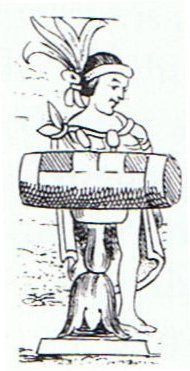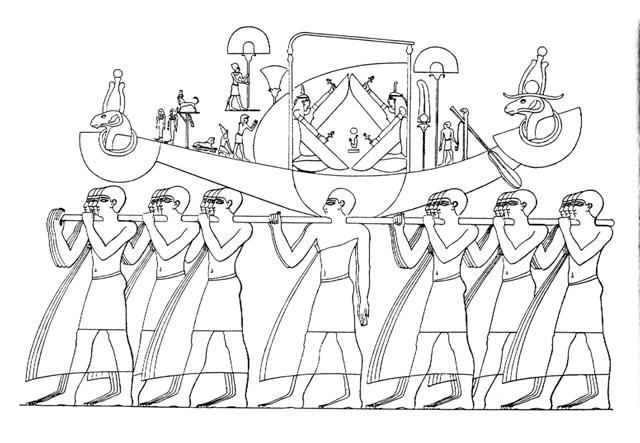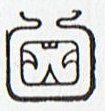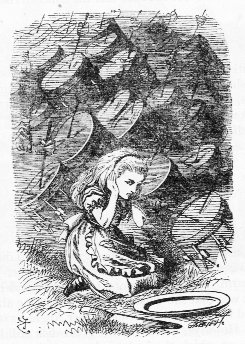Maui
lifted
up
'Land'
with
his
enchanted
fish-hook
and
the
Eagle
lifted
up
in
his
claws the
Dead
Man
(possibly
corresponding
to
Castor
-
the
Beaver
- as
the
personification
of
the
time
of
the
'Water').
...
This
act
of
Maui's,
that
gave
our
people
the
land
on
which
we
live,
was
an
event
next
in
greatness
to
the
separation
of
the
Sky
and
Earth
...

His
feat
was
comparable
to
the
separation
of
Sky
(Ranginui) and
Earth
(Papatuanuku) because
this
place
once
upon
a
time
had indeed
been
the
place
where
Sky
and
Earth
were
separated:
... They
were
Ranginui,
the Sky
Father, and
Papatuanuku,
the Earth
Mother, both
sealed
together in
a close
embrace.
Crushed
between the
weight of
their bodies
were their
many
children,
whose
oppression
deepened.
They yearned
to be free;
they fought
their
parents and
each other
to break
loose.
Tuumatauenga,
virile god
of war,
thrust and
shouted;
Tangaroa
of the
oceans
whirled and
surged;
Tawhirirangimaatea howled
with many
raging
winds;
Haumiatiketike
and
Rongomatane,
of wild
foods and
cultivated
crops tried
their best
but were not
successful;
and
Ruamoko,
god of
earthquakes,
yet to be
born,
struggled in
the
confinement
of his
mother's
womb.
Of
them all,
Taane Mahuta,
the god of
the forests,
was the most
determined;
he set his
sturdy feet
upon his
father's
chest, and
braced his
upper back
and
shoulders
against the
bosom of his
mother. He
pushed; and
they parted.
So the
world; as
the Maori
understand
it; came
into being
...
Around
71 *
64 =
4500
years
ago the
heliacal
stars
at
Ga2-11 had
been
with
the
Sun
only
41
days
after
0h.
Precession
had
since
then
carried
the
Sun
yet
earlier
in
the
year
with
about 64
days.
41 +
64 =
105
(15
weeks).
MAY
1
(121)
at
Ga2-11
had
become
July
4
(185)
at
the
time
of
rongorongo:
 |
 |
 |
 |
| Ga2-9 |
Ga2-10 (40) |
Ga2-11 |
Ga2-12 |
| APRIL 29 (*39) |
30 |
MAY 1 (121) |
2 (*407) |
| Mash-mashu-sha-Risū-10 |
Adara (104.8) |
ω Gemini (105.4), Alzirr (105.7), Muliphein (105.8), Mekbuda (105.9) |
7h (106.5) |
| θ Gemini (103.0), ψ8 Aurigae (103.2), Alhena (103.8), ψ9 Aurigae (103.9) |
no star listed (106) |
| July 2 |
3 |
4 (181 + 4) |
5 |
| ºJune 28 |
29 (*100) |
30 |
ºJuly 1 (182) |
| 'June 5 |
6 |
7 (*78) |
8 |
| "May 22 |
23 |
24 (144) |
25 (*65) |
| NAKSHATRA DATES: |
| OCTOBER 29 (*222) |
30 |
31 |
NOVEMBER 1 (305) |
| χ Oct. (286.0), Ain al Rami (286.2), δ Lyrae (286.3), κ Pavonis (286.5), Alya (286.6) |
ξ Sagittarii (287.1), ω Pavonis (287.3), ε Aquilae, ε Cor. Austr., Sulaphat (287.4), λ Lyrae (287.7), Ascella, Bered (Ant.) (287.9) |
Al Na'ām-18 / Uttara Ashadha-21 |
19h (289.2) |
| NUNKI (288.4), ζ Cor. Austr. (288.5), Manubrium (288.8), ζ Aquilae (288.9) |
λ Aquilae (Ant.) (289.1), γ Cor. Austr (289.3), τ Sagittarii (289.4), ι Lyrae (289.5), δ Cor. Austr. (289.8) |
| January 1 (366) |
2 |
3 |
4 |
| ºDecember 28 |
29 |
30 (364) |
31 (*285) |
| 'December 5 |
6 |
7 |
8 (342) |
| "November 21 (325) |
22 |
23 |
24 (*248) |
... The
tun
glyph was
identified
as a wooden
drum by
Brinton ...
and Marshal
H. Saville
immediately
accepted it
... [the
figure
below] shows
the Aztec
drum
representation
relied on by
Brinton to
demonstrate
his point.
It was not
then known
that an
ancestral
Mayan word
for drum was
*tun:
Yucatec
tunkul
'divine
drum' (?);
Quiche
tun
'hollow log
drum';
Chorti
tun
'hollow log
drum' ...

...
The
[tun]
glyph
is
nearly
the
same
as
that
for
the
month
Pax
...
except
that
the
top
part
of
the
latter
is
split
or
divided
by
two
curving
lines.
Brinton,
without
referring
to
the
Pax
glyph,
identified
the
tun
glyph
as
the
drum
called
in
Yucatec
pax
che
(pax
'musical
instrument';
che
<
*te
'wooden).
Yucatec
pax
means
'broken,
disappeared',
and
Quiche
paxih
means,
among
other
things,
'split,
divide,
break,
separate'.
It
would
seem
that
the
dividing
lines
on
the
Pax
glyph
may
have
been
used
as a
semantic/phonetic
determinative
indicating
that
the
drum
should
be
read
pax,
not
tun
...
Thus,
one
may
expect
that
this
glyph
was
used
elsewhere
meaning
'to
break'
and
possibly
for
'medicine'
(Yuc.
pax,
Tzel.,
Tzo.
pox) ...
Mago
in
Ga2-14
has
an
inside
line
up
but
no
such
down
-
this
was
presumably
the
curving
end
of
the
first
half
of
Sun's
path,
with
Wasat
('middle'
in
the
following
Gregorian
day
185).
In
Roman
times
mago
in
Ga2-14
was
at
'June
10,
when
the
month
celebrating
Father
Light
(Jupiter)
began:
...
Midsummer is
the
flowering
season of
the oak,
which is the
tree of
endurance
and triumph,
and like the
ash is said
to 'court
the
lightning
flash'. Its
roots are
believed to
extend as
deep
underground
as its
branches
rise in the
air - Virgil
mentions
this - which
makes it
emblematic
of a god
whose law
runs both in
Heaven and
in the
Underworld
... The
month, which
takes its
name from
Juppiter the
oak-god,
begins on
June 10th
and ends of
July 7th.
Midway comes
St. John's
Day, June
24th, the
day on which
the oak-king
was
sacrificially
burned
alive. The
Celtic year
was divided
into two
halves with
the second
half
beginning in
July,
apparently
after a
seven-day
wake, or
funeral
feast, in
the
oak-king's
honour
...
 |
 |
 |
 |
 |
| Ga2-13 |
Ga2-14 |
Ga2-15 |
Ga2-16 (46) |
Ga2-17 |
| MAY 3 (*408) |
4 |
5 (125) |
6 (*46) |
7 |
| Wezen (107.1), τ Gemini (107.7), δ Monocerotis (107.9) |
no star listed (108) |
λ Gemini (109.4), Wasat (109.8) |
no star listed (110) |
Aludra (111.1), Propus (111.4), Gomeisa (111.6) |
| July 6 (*107) |
7 (188) |
8 |
9 |
10 |
| ºJuly 2 |
3 |
4 (185) |
5 |
6 (*107) |
| 'June 9 (*80) |
10 (161) |
11 |
12 |
13 |
| "May 26 |
27 |
28 (*68) |
29 |
30 (150) |
| NAKSHATRA DATES: |
| NOVEMBER 2 |
3 |
4 (*228) |
5 |
6 (310) |
| Al Baldah-19 |
Aladfar (291.1), Nodus II (291.5), ψ Sagittarii (291.6), θ Lyrae (291.8) |
ω Aquilae (292.1), ρ Sagittarii (292.6), υ Sagittarii (292.7) |
Arkab Prior (293.0), Arkab Posterior, Alrami (293.2), χ Sagittarii (293.6) |
Deneb Okab (294.0), α Vulpeculae (294.9) |
| AL BALDAH, Alphekka Meridiana (290.1), β Cor. Austr. (290.2) |
| January 5 |
6 |
7 (372) |
8 |
9 |
| ºJanuary 1 |
2 |
3 (*288) |
4 |
5 (370) |
| 'December 9 |
10 (344) |
11 (*265) |
12 |
LUCIA |
| "November 25 (329) |
26 (*250) |
27 |
28 |
29 |
 |
 |
 |
|
 |
 |
 |
| Ga2-18 |
Ga2-19 |
Ga2-20 (50) |
Ga2-21 |
Ga2-22 |
Ga2-23 |
| MAY 8 (*413) |
9 |
10 (130) |
11 |
12 |
13 (*53) |
| Ghost-23 |
Al Dhirā'-5 / Punarvasu-7 / Mash-mashu-Mahrū-11 |
ANA-TAHUA-VAHINE-O-TOA-TE-MANAVA |
α Monocerotis (115.4), σ Gemini (115.7) |
Mash-mashu-arkū-12 |
Azmidiske (117.4) |
| ρ GEMINI (112.1), Eskimo Nebula (112.2)
Antares
|
CASTOR (113.4) |
υ Gemini (114.0), Markab Puppis (114.7), ο Gemini (114.8), PROCYON (114.9) |
κ Gemini (116.1), POLLUX (116.2), π Gemini (116.9) |
| July 11 |
12 (193) |
13 |
14 |
15 (196) |
16 |
| ºJuly 7 (*108) |
8 |
9 |
10 |
11 (384 / 2) |
12 |
| 'June 14 |
15 |
16 |
17 (*88) |
18 |
19 |
| "May 31 (151) |
"June 1 |
2 (*73) |
3 |
4 |
5 |
| NAKSHATRA DATES: |
| NOV 7 (*231) |
8 |
9 |
|
10 (314) |
11 |
12 |
| ν Aquilae (Ant.) (295.0), Albireo (295.5) |
μ Aquilae (296.3), ι Aquilae (Ant.) (296.8), κ Aquilae (Ant.) (296.9) |
ε Sagittae (297.1), σ Aquilae (Ant.) (297.4), Sham (297.8) |
β Sagittae (298.0), χ Aquilae (298.3), ψ Aquilae (298.8) |
υ Aquilae (299.1), Tarazed (299.3), δ Sagittae (299.6), π Aquilae (299.9) |
Sravana-23 |
| ζ Sagittae (300.1), ALTAIR (300.3), ο Aquilae (300.5), Bezek (300.8) |
| January 10 |
11 |
12 (377) |
13 |
14 |
15 |
| ºJanuary 6 |
7 (372) |
8 |
9 |
10 (*295) |
11 |
| 'December 14 |
15 |
16 (350) |
17 |
18 |
19 |
| "November 30 |
"December 1 |
2 (336) |
3 |
4 |
5 (*259) |
 |
 |
 |
| Ga2-24 (54) |
Ga2-25 |
Ga2-26 |
| MAY 14 |
15 (500) |
16 (136) |
| φ Gemini (118.4) |
Drus (119.9) |
ω Cancri (120.2) |
| July 17 (*118 = 472 / 4) |
18 |
19 (200) |
| ºJuly 13 |
14 (195) |
15 (*116) |
| 'June 20 (171 - 80 + 366 = *457) |
Solstice |
22 (*93) |
| "June 6 (*77) |
7 (*444) |
8 (525) |
| NAKSHATRA DATES: |
| NOVEMBER 13 (*237) |
14 |
15 (319) |
| ι Sagittarii (301.2), Terebellum, ξ Aquilae (301.3), Alshain (301.6), φ Aquilae (301.8) |
ε Pavonis, θ Sagittarii (302.3), γ Sagittae (302.5), μ Pavonis (302.7) |
τ Aquilae (303.8) |
| January 16 (*301) |
17 |
1-18 (383) |
| ºJanuary 12 |
13 (378) |
14 (*299) |
| 'December 20 (354) |
Solstice |
22 |
| "December 6 (*260) |
7 |
8 (342) |
The
'claw
of
the
Eagle'
in
Ga2-26
resembles
that
in
Cb4-20,
which
is a
rare
opportunity
for
comparison
between
the
rongorongo texts and
reasonably
it
should
therefore be
at
the
time
of a
very
important
event:
...
Ga2-26
can
be
compared
with
Cb4-20:
 |
 |
 |
 |
| Cb4-17 (480) |
Cb4-18 |
Cb4-19 |
Cb4-20 (91) |
| erua marama |
tagata noho i to mea |
kua vaha |
| ANA-TAHUA-VAHINE-O-TOA-TE-MANAVA |
α Monocerotis (115.4), σ Gemini (115.7) |
POLLUX (116.2) |
Azmidiske (117.4) |
| Markab Puppis (114.7), PROCYON (114.9) |
| July 13 (*480) |
14 |
15 (196) |
16 |
| ε Sagittae (297.1), σ Aquilae (Ant.) (297.4), Sham (297.8) |
β Sagittae (298.0), χ Aquilae (298.3), ψ Aquilae (298.8) |
υ Aquilae (299.1), Tarazed (299.3), δ Sagittae (299.6), π Aquilae (299.9) |
Sravana-23 |
| ζ Sagittae (300.1), ALTAIR (300.3), ο Aquilae (300.5), Bezek (300.8) |
| January 12 (377) |
13 |
14 |
15 (*300) |
Cb4-20 is glyph 91 (= 7 * 13) counted from the beginning of side b, i.e. counted from October 17 (290) - or from 'September 20 (263). Ga2-26 is glyph 56 (= 7 * 8) counted from the beginning of side a, i.e. counted from November 23 (327) - or from 'October 27 (300). There is a 3 day difference between the positions of this type of glyph in the texts ...
Possibly this great event was defined from day *300 at nakshatra Altair in the C text but in the G text from heliacal ω Cancri in MAY 16 (136) - as an allusion to Temennu (the Foundation Stone, Alcyone) rising with the Sun in May 16 (64 days earlier):
 |
 |
 |
 |
 |
 |
 |
| (229 or 2 * 229) |
Gb8-18 |
Gb8-19 |
Gb8-20 (461) |
Gb8-21 |
Gb8-22 |
Gb8-23 (235) |
| MARCH 7 |
8 |
9 |
10 (*354) |
11 (70) |
12 |
13 |
| ALGENIB PERSEI (50.0), ο Tauri (50.2), ξ Tauri (50.8) Gienah
|
no star listed (51) |
no star listed (52) |
no star listed (53)
Acrux
|
no star listed (54) |
Al Thurayya-27 / Krittikā-3 / Hairy Head-18 / Temennu-4 |
| Atiks, Rana (55.1), CELAENO, ELECTRA, TAYGETA (55.3), MAIA, ASTEROPE, MEROPE (55.6) |
ALCYONE (56.1), PLEIONE, ATLAS (56.3) |
| TAU-ONO |
| May 10 (*50) |
11 |
12 |
13 |
14 (134) |
15 (500) |
16 |
| 'April 13 |
14 |
15 |
16 (471) |
17 (107) |
18 |
19 (*29) |
| "March 30 |
31 |
"April 1 |
2 (457) |
3 (93) |
4 |
5 (*15) |
| NAKSHATRA DATES: |
| SEPTEMBER 6 |
7 |
8 |
9 (*172) |
10 |
11 |
12 (255) |
| Alkalurops (233.1) |
Nusakan (234.0), κ¹ Apodis (234.3), ν Bootis (234.7) |
θ Cor. Borealis (235.3), γ Lupi (235.6), Gemma, Zuben Elakrab, Qin, ε Tr. Austr. (235.7), μ Cor. Borealis (235.8)
Sirrah
|
φ Bootis (236.2), ω Lupi (236.3), ψ¹ Lupi (236.7), ζ Cor. Borealis (236.9) |
ι Serpentis (237.4), ρ Oct., ψ² Lupi (237.5), γ Cor. Borealis (237.7), Unuk Elhaia (237.9) |
π Cor. Borealis, Cor Serpentis (238.1), Chow (238.6) |
κ Serpentis (239.3), δ Cor. Borealis, Tiānrǔ (239.5), χ Lupi, (239.6), ω Serpentis (239.7), Ba, χ Herculis (239.8). κ Cor. Borealis, ρ Serpentis (239.9) |
| November 9 |
10 (314) |
11 |
12 (*236) |
13 |
14 |
15 |
| 'October 13 |
14 |
15 (288) |
16 |
17 (*210) |
18 |
19 |
| "September 29 |
30 (*193) |
"October 1 |
2 |
3 (12 * 23) |
4 |
5 |
At the time of the Hyades Gate the Queen of Sailing would have risen with the Sun in MARCH 13, the day before 3-14. And ships are always female.

|


















